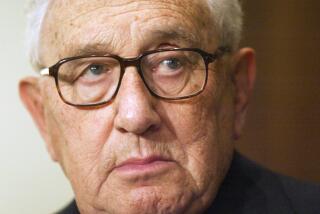Nixon, Kissinger View on Arms
- Share via
In their article (Opinion, April 26), “To Withdraw Missiles, We Must Add Conditions,” former President Richard M. Nixon and former Secretary of State Henry A. Kissinger argue that the agreement now being negotiated between the United States and the Soviet Union to globally eliminate almost all U.S. and Soviet intermediate nuclear force weapons would be a “profound mistake” unless at least two additional conditions are met. These are not that just almost all, but all U.S. and Soviet intermediate nuclear force weapons should be eliminated globally, and that any such agreement should be linked to elimination of “the huge Soviet conventional superiority.”
As to their first objection, they argue that any SS-20 missiles withdrawn to Soviet Asia would still threaten Germany, could easily be moved to positions threatening all of Europe, and would threaten China, Japan, and Korea with U.S. acquiescence; and that permitting 100 SS-20 warheads in Asia would greatly complicate the verification problem. None of these points is compelling, either singly or collectively.
If, as the authors also point out, the Soviets would be left with 19,000 nuclear warheads with which to threaten Western Europe (a large proportion are on accurate ICBMs and they threaten Asia also) how is it that an additional 100 warheads pose such a severe military threat either to Europe or to Asia?
Yes, verification does become a more difficult problem, but not necessarily an “enormous” one. But both the United States and the Soviet Union have described their respective verification proposals as “very intrusive.” Before reaching any conclusion, let’s wait for the actual verification provisions.
What about their argument that “elimination of the huge Soviet conventional superiority” should be linked to the final phase of missile withdrawals so that Europe is not made “safe for conventional war?” Nixon and Kissinger argue that deterrence in present-day Europe can not be based on U.S. battlefield weapons or tactical bombers, and here I agree with them, although it is useful to remind the reader that battlefield nuclear weapons can include missiles with up to 300 miles range. But also remaining would be U.S. sea-based missiles assigned to NATO, and British and French land- and sea-based intermediate range missile forces, which are unrestricted by any treaty and which are now being expanded by several thousand warheads, far more than the number of U.S. warheads, which an intermediate nuclear force treaty would remove. Deterrence against Soviet attack in Central Europe should not and can not remain the sole U.S. responsibility.
Elimination of all U.S. and Soviet intermediate nuclear force weapons, save for 100 warheads allowed for each side, is not a perfect agreement, but it is worthwhile. It makes the world a more dangerous place only if we allow it to. An agreement to eliminate U.S. and Soviet intermediate nuclear force weapons would be more satisfactory if all such weapons were eliminated globally and if a conventional force balance were achieved, but to so condition the intermediate nuclear force agreement would, in the words of Nixon and Kissinger, be a profound mistake.
BERNARD SPRINGER
Encino
More to Read
Sign up for Essential California
The most important California stories and recommendations in your inbox every morning.
You may occasionally receive promotional content from the Los Angeles Times.













